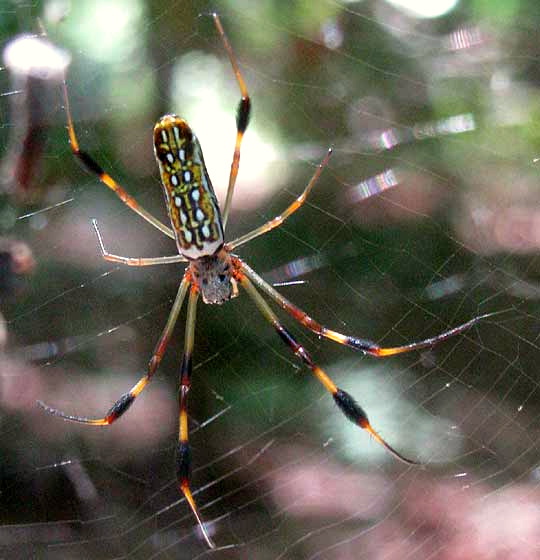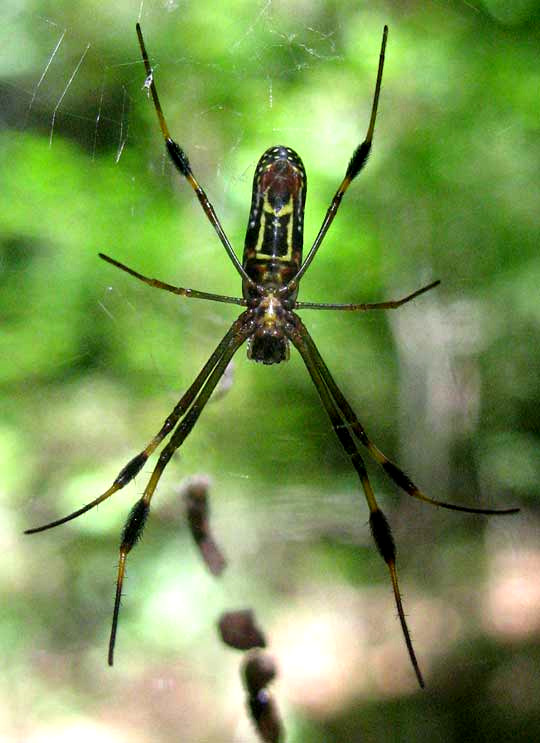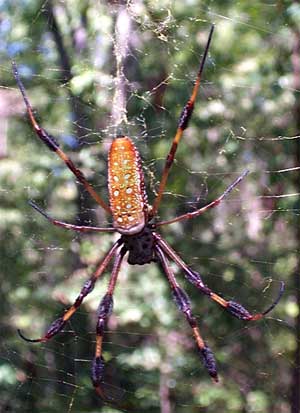Excerpts from Jim Conrad's
Naturalist Newsletter
from the June 24, 2012 Newsletter issued from the woods of the Loess Hill Region a few miles east of Natchez, Mississippi, USA
GOLDEN SILK SPIDER
Below we have earlier notes on this species. This week, rather early in the season for them, I got some better pictures. Below is a view of the mostly white and golden top:

A bottom view showing a distinctive yellowish marking is below:

from the October 6, 2006 Newsletter, written near Natchez, Mississippi, USA
GOLDEN SILK SPIDER INVASION
 In my September 1, 2002 Newsletter I wrote "I've encountered about ten webs of one of the most striking spiders we have here. It's the Golden Silk Spider, NEPHILA CLAVIPES, a species native throughout the American tropics and subtropics from Argentina and Peru north to the southeastern US. From the tip of its hind legs to the tip of its front legs it's about 3.75 inches long (9.5 cm). Besides its large size, the two striking things about its appearance are its yellowish, prettily patterned rear end (its abdomen), and the conspicuous tufts of long, black hairs at the 'elbows' on its eight legs."
In my September 1, 2002 Newsletter I wrote "I've encountered about ten webs of one of the most striking spiders we have here. It's the Golden Silk Spider, NEPHILA CLAVIPES, a species native throughout the American tropics and subtropics from Argentina and Peru north to the southeastern US. From the tip of its hind legs to the tip of its front legs it's about 3.75 inches long (9.5 cm). Besides its large size, the two striking things about its appearance are its yellowish, prettily patterned rear end (its abdomen), and the conspicuous tufts of long, black hairs at the 'elbows' on its eight legs."
That's one of our Golden-silk Spiders at the right.
So, Golden Silk Spiders have been in this area for a while, but in 2002 I considered finding ten of their webs something special. Thing is, in the countryside I've walked through the last few days I've seen hundreds of them, if not thousands. I'm not alone in thinking that not long ago they were rare or absent, but now they're abundant. Karen says she often sees numerous webs side by side among overhead power lines. "If they'd been here years ago, I'm sure I'd remember something spectacular as that!" she says.
They do indeed place several webs together, with one, two or more spiders in each web. The second spider is usually the much smaller male, and if there's a third spider it may be a "kleptoparasitic" species -- one living on food collected in the web that's been discarded, overlooked or ignored by the larger spider.
The Golden Silk Spider's web silk is indeed golden colored, plus it's stronger than the silk of any web I've encountered in the US. It can certainly ensnare dragonflies and I wouldn't be surprised to find a hummingbird in a web someday. These spiders are larger and more robust-looking than the somewhat similar Garden Spider, or Argiope. In fact, it might be the largest orb-weaving spider in the US. Several times during my walk I saw webs stretched from tree to tree high across two-laned paved roads.
Since this is a mostly tropical or subtropical species it displays some interesting adaptations for dealing with strong sunlight. Its dominant pale yellow and white coloration help reflect sunlight, plus in the picture notice its abdomen's long, cylindrical shape. In bright sunlight it can point its abdomen toward the sun, thus drastically reducing the abdomen's surface area exposed to sunlight.
Is this Golden Silk Spider population explosion yet another indication of global warming -- of the tropics moving northward?